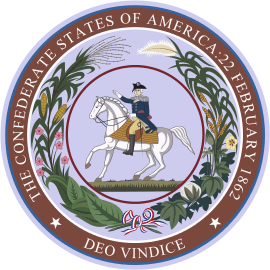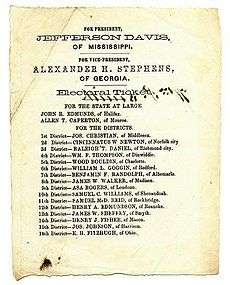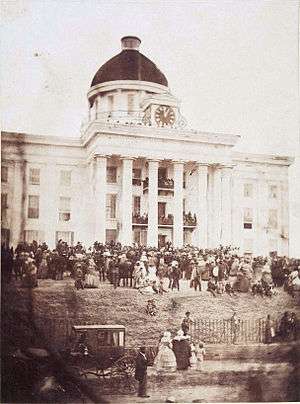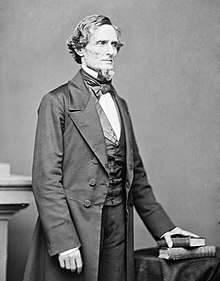President of the Confederate States of America
| President of the Confederate States of America | |
|---|---|
 | |
| Style | His Excellency |
| Residence |
|
| Seat |
|
| Appointer | |
| Term length |
|
| Formation |
|
| First holder | Jefferson Davis |
| Final holder | Jefferson Davis |
| Abolished | May 10, 1865 |
| Deputy |
Vice-President of the Confederate States |
| Salary | CS$25,000 per annum |
The President of the Confederate States of America was the elected head of state and government of the Confederate States. The president also headed the executive branch of government and was commander-in-chief of the Army and Navy, and of the militia of the several states when called into Confederate service.[1]
Article II of the Confederate States Constitution vested the executive power of the Confederacy in the president. The power included the execution of law, alongside the responsibility of appointing executive, diplomatic, regulatory and judicial officers, and concluding treaties with foreign powers with the advice and consent of the senate. He was further empowered to grant reprieves and pardons, and convene and adjourn either or both houses of Congress under extraordinary circumstances.[1]
The president was indirectly elected by the people through the Electoral College to a six-year term, and was one of only two nationally elected Confederate officers, the other being the Vice President. On February 18, 1861, Jefferson Davis became president of the provisional government. On February 22, 1862, he became president of the permanent government and served in that capacity until being captured by elements of the United States Cavalry in 1865.[2]
Powers and duties
The constitutional powers of the President of the Confederate States were similar to those of the President of the United States. The permanent Confederate States Constitution made him commander-in-chief of the Army and Navy, and of the militia of the confederated states when called into service of the Confederate States. He was also empowered to grant reprieves and pardons for offenses against the Confederate States. He was authorized to make treaties; to nominate and appoint diplomatic representatives, judges, and other officers of the Confederate States (including the heads of the executive departments) by and with the consent of the Confederate States Senate; and to remove such representatives and officers. He could fill vacancies during a recess of the Senate, but he could not reappoint, during a recess, persons previously rejected by it. He was to supply Congress with information, recommend legislation, receive ambassadors and other public ministers, see that the federal laws were faithfully executed, and commission all officers of the military and naval forces of the Confederate States.[2]
Election and oath


On February 9, 1861, the provisional congress at Montgomery unanimously elected Jefferson Davis president and Alexander H. Stephens vice president. Stephens, who was a delegate to Congress from Georgia, was inaugurated on February 11. Davis was inaugurated on February 18 upon his arrival from Mississippi, where he had gone upon his resignation from the U.S. Senate. Davis and Stephens were elected on Wednesday November 6, 1861, for six-years terms, as provided by the permanent constitution. The Capital had been moved in June 1861, to Richmond, and the inauguration took place at the statue of Washington, on the public square, on February 22, 1862.[2]
Before Davis entered on the execution of his office as President of the Confederate States, he was constitutionally required to take the following oath or affirmation:
I do solemnly swear (or affirm) that I will faithfully execute the office of President of the Confederate States, and will, to the best of my ability, preserve, protect, and defend the Constitution thereof.[1]
Compensation
In 1861, the President of the Confederate States earned a CS$25,000 annual salary, along with an expense account, and a nontaxable travel account.[3] The President's Office was located on the second floor of the Custom House on Main Street, a structure which also housed the Cabinet Room and the State and Treasury Department. The City of Richmond purchased the Brockenbrough house for presentation to the Confederate government for use as an executive mansion. Davis declined to accept the gift, but the mansion was leased for his use. Referred to as the "White House of the Confederacy" or the "Grey House," the mansion was used by President Davis throughout the existence of his presidency. Later it became a repository for documents, relics, and pictures, and in 1896 it was redesignated the Confederate Museum.[2]
Post-presidency
Late on the evening of April 2, 1865, President Davis, his aides, and members of the Presidential Cabinet, except C.S. Secretary of War John C. Breckinridge, departed from the burning capital city of Richmond going southwest on the Richmond and Danville Railroad shortly before Union troops occupied it. The Confederate President Davis and his Cabinet stayed at Danville, 140 miles (225 km) southwest of Richmond, until April 10, when, hearing of General Lee's surrender at Appomattox Court House further northeast, it continued its flight farther south.
At Greensboro, North Carolina, on April 12 the Cabinet met with Generals Joseph E. Johnston and Pierre G. T. Beauregard and discussed surrender of Johnston's Army of Tennessee to Union General William Tecumseh Sherman then in nearby North Carolina moving north from Savannah through the Carolinas destroying, pillaging and burning everything in its path including Columbia the South Carolina state capital city.
As the railroad leading south out of Greensboro had already been destroyed, the flight from that location was changed to on horseback and in a train of additional wagons, ambulances, and carriages, also carrying some Confederate archives papers and the C.S.A. Treasury banknotes and remnants of gold/silver bullion. The last official Cabinet meetings of the Presidential Cabinet of the Confederate States took place at Charlotte, on April 24, and 26, then later on May 4; when President Davis left Washington, Georgia, the party consisted only of his aides and Postmaster General Reagan. Elements of the United States Cavalry / Union Army captured Davis and his companions at an encampment near Irwinville, Georgia, May 10, 1865.[2]
Jefferson Davis was imprisoned at Fort Monroe, by the Hampton Roads harbor of tidewater Virginia, until his release on bail on May 13, 1867. During his confinement, the United States federal government prepared to bring him to trial for treason and for complicity in the assassination of United States President Abraham Lincoln. He could not be tried in the Commonwealth of Virginia until the Federal court was reestablished there, but by the time the U.S. Circuit Court judges were prepared in May 1867, the U.S. Federal government decided the outcome of a trial before a local jury of citizens was far too uncertain and dropped the prosecution proceedings. In November 1868, Davis was brought to trial under a new indictment, but the Federal lower court judges disagreed and the case was referred up to the Supreme Court. 17th President Andrew Johnson issued a general amnesty in December 1868 and the Supreme Court entered a nolle prosequi, thus freeing Davis.[2]
List of presidents
| № | Portrait | President | State | Term of office | Party | Term | Previous office | Vice President | ||
|---|---|---|---|---|---|---|---|---|---|---|
| 1 |  |
Jefferson Davis June 3, 1808 – December 6, 1889 (Aged 81) |
Mississippi | February 18, 1861 [n 1] – May 10, 1865 |
Non-partisan | 1 (1861) |
U.S. Senator from Mississippi (1857–1861) |
Alexander H. Stephens | ||
Notes
- ↑ Jefferson Davis initially took an oath of office as President of the Confederate States of America on February 18, 1861, in Montgomery, Alabama, under conditions set forth in the Constitution of the Provisional Government. After being directly elected to the presidency, he took another oath of office (this time for a six-year term) on February 22, 1862, in Richmond, Virginia, as prescribed in the "permanent" Constitution of the Confederate States.
Fictional Presidents of the Confederate States of America
- Jake Featherston, a fictional character in the Southern Victory novel series by Harry Turtledove. The fictional timeline's equivalent of Adolf Hitler, he is motivated by his desire to fight a second war against the United States as revenge for the Confederacy's humiliating defeat in the First Great War and to eliminate the Confederacy's black population and its ruling aristoracy, believing that the former had 'stabbed the South in the back' and that the latter had incompetently led the Confederacy via the War Department and the Whig Party during the First Great War. He is the head of the Freedom Party, having been its presidential candidate in Confederate presidential elections since 1921.
- Robert E. Lee is often depicted as an Independent successor to Jefferson Davis successor as President in American Civil War alternate histories such as Bring the Jubilee and Guns of the South. However, in the Southern Victory Series, a 'President Lee' is mentioned with Robert E. Lee often being referred to in the series only as a general; it is never specified whether it is him, his son Rooney Lee or his nephew Fitzhugh Lee.
- Wade Hampton V, a fictional character in the Southern Victory novels by Harry Turtledove. The fictional descendent of Wade Hampton III, Hampton is elected President in 1921 over Jake Featherston (Freedom Party) and Ainsworth Layne (Radical Liberal), but is assassinated by Freedom Party stalwart Grady Calkins in Birmingham, Alabama in June 1922. In this alternate timeline, Hampton is the first President in either US or CS history to be assassinated.
- James Longstreet is depicted as the 4th President of the Confederate States in How Few Remain by Harry Turtledove. His presidency saw the Confederate purchase of Sonora and Chihuahua from the Mexican Empire, a Confederate victory in the Second Mexican War (1881-1882) and the manumission of the Confederate slave population.
- Burton Mitchel, a fictional character in the Southern Victory novels by Harry Turtledove. Possibly the fictional descendent of Charles B. Mitchel, Mitchel becomes President in 1922 after the assassination of Wade Hampton V and successfully runs for election in 1927 after the Confederate Supreme Court rules that he was eligible despite serving out more than five years of his predecessor's term. After the start of the Great Depression in 1929, Mitchel is blamed for the Confederacy's economic woes, with shanty towns across the country being dubbed "Mitcheltowns" (the equivalent of the U.S.'s "Blackfordburghs" and the "Hoovervilles" of our own realistic timeline). Mitchel would be the last Whig Party President of the Confederacy after his defeat to Jake Featherston in the 1933 presidential election.
- Donald Partridge, a fictional character in the Southern Victory novels by Harry Turtledove. A caricature of Dan Quayle, he became Vice President after an unsuccessful coup led by his predecessor Willy Knight (being considered Knight's polar opposite, a useless, harmless idiot who spent most of his time telling Featherston dumb farm-girl jokes and spending time in the company of various women). He eventually became C.S. President after Jake Featherson was assassinated by Cassius Madison, overseeing the Confederacy's surrender to and subsequent annexation by the United States after the Second Great War (1941-1944).
- Gabriel Semmes, a fictional character in the Southern Victory novels by Harry Turtledove. The possible descendent of southern Naval captain Raphael Semmes, Semmes succeeds Woodrow Wilson as President in 1916, having defeated Radical Liberal opponent Doroteo Arango in the 1915 presidential election. Semmes oversees the Confederate effort in the First Great War from 1916 until its eventual defeat by the United States in 1917.
- Woodrow Wilson is depicted as the 9th President of the Confederate States in the Southern Victory novels, leading the Confederacy in the First Great War (1914-1917), [paralleling the real World War I) but on the side of the Entente (with the German Empire) as a lame duck.
See also
References
- 1 2 3 C.S. Congress (provisional) (May 1861) [1st pub. March 1861]. "Article II". C.S. Constitution. Constitutional Convention. Syme & Hall, Printers to the Convention.
- 1 2 3 4 5 6 Beers, Henry Putney (2004) [1st pub. United States Government Publishing Office:1968]. "Chapter IV: The Presidency". The Confederacy: A Guide to the Archives of the Government of the Confederate States of America. Washington, D.C.: National Archives and Records Administration. pp. 62–71. ISBN 0-911333-18-5 – via National Archives Trust Fund Board.
- ↑ Vanfelson, C. A. (1861). The Little Red Book or Department Directory: For the Use of the Public in the Confederate States of America. Richmond: Tyler, Wise and Allegre, Printers. p. 4. OCLC 52558640 – via Enquirer Job Office.
Further reading
- Henry, Robert Selph (1931). "Chapter VII: Government, Provisional and "Permanent"". The Story of the Confederacy (1st ed.). Garden City, New York: Garden City Publishing Company. pp. 88–99. OCLC 1300151 – via The Bobbs-Merrill Co.
- McPherson, James M. (2014). Embattled Rebel: Jefferson Davis as Commander in Chief. New York: The Penguin Press. ISBN 978-1-59420-497-5. OCLC 870248703.